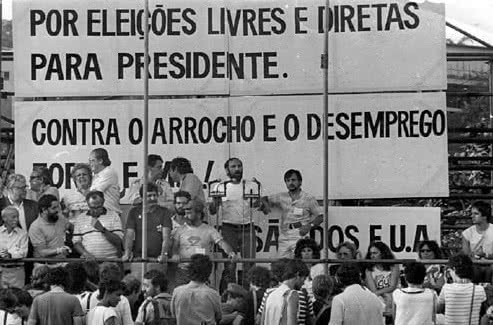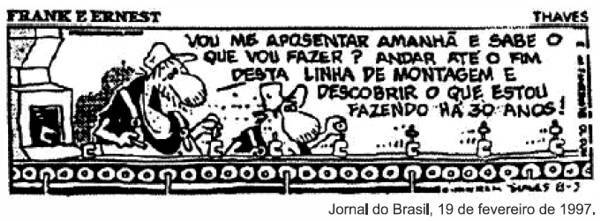It is considered that there was democratization of Brazil in two moments of its republican history:
- In 1945 - when Getúlio Vargas was dismissed;
- In 1985 - at the end of the military dictatorship.
Democracy
Before understanding what “redemocratization” is, it is necessary to define democracy.
The word democracy comes from the Greek meaning the government of the people, where sovereignty is in the people.
As it is not possible for an entire population to govern, the people cede their power to political representatives. This is called representative democracy.
In this way, when the people have their fundamental freedoms taken away, they are living under a dictatorship. Importantly, dictatorships can be civil or military.
Thus, “redemocratizing” would be to return democracy to societies that suffered the dictatorship.
Estado Novo (1937-1945)
In 1937, Getúlio Vargas dissolved Congress and granted a new Constitution to the nation. It bans political parties and ends presidential elections.
In addition, it maintains the political police and prior censorship in newspapers and shows. This period is known as the Estado Novo.
Therefore, it is considered that at this moment there was a democratic interruption in the republican history of Brazil.
End of the New State (1945)
In the 1940s, the Estado Novo was no longer unanimous among the Brazilian elite.
One of the documents that reflects this dissatisfaction is the "Manifesto dos Mineiros". Clandestinely written in 1943, Minas Gerais state intellectuals criticize the government. The Manifesto would be published in the press and several of its authors would be arrested.
Another reason was Brazil's participation in World War II. After all, Brazil had gone to fight fascism in Europe and lived under a regime that had dictatorial similarities.
In 1945, Getúlio Vargas suffered a military coup supported by the UDN (National Democratic Union).
Despite having built the image of the “Father of the Poor”, there was no record of any attempt to defend the Getúlio Vargas regime by the population.

Redemocratization (1945)
As we have seen, redemocratization means returning sovereignty to the people and this can only be done through free elections.
As Getúlio Vargas had extinguished the figure of the vice president, the President of the Federal Supreme Court, José Linhares, took over.
Linhares guaranteed the holding of presidential and parliamentary elections where several political parties, including the communist one, could compete. The winner of the election was General Eurico Gaspar Dutra, of the PSD (Social Democratic Party).
Then, the second step to redemocratize a society is to change the Constitution.
Thus, the deputies elected to the Congress of Deputies, formed the National Constituent Assembly and promulgated the Constitution in September 1946.
Despite the return of several constitutional guarantees, this redemocratization process was revealed to be incomplete very early on. The Communist Party was declared illegal in 1947 and the right to vote was forbidden to the illiterate.
Military Regime (1964 - 1985)
In 1964, the military, supported by part of Brazilian society, removed President João Goulart, in the name of national security.
The military spent 21 years in power and alternated the country's presidency among themselves in indirect elections.
In 1967, they established a new Constitution. In it, they suppressed the direct vote to the Executive, instituted prior censorship of the media and restricted the right to association.
From the Geisel government to the Opening
With the end of the "economic miracle" promoted by the military in the 70s, the population began to show signs of discontent with the military regime. It was also increasingly difficult to hide the torture and disappearance of people persecuted by the regime.
A part of the military perceived that their days were numbered and fearing reprisals, they proposed a “slow, gradual and safe opening”. In this way, civil rights would be gradually returned to the population.
Thus, in Ernesto Geisel's government (1974-1979), there are timid changes in the political scenario:
- AI-5 was replaced by constitutional safeguards;
- the journalist's death Vladimir Herzog by the military it managed to circumvent the censorship imposed on newspapers and generated protests against the government;
- Brazil re-established diplomatic relations with countries under the communist regime such as China, Bulgaria, Hungary and Romania.
In the Figueiredo government (1978-1985), new laws that favor political opening were sanctioned:
- Revocation of AI-5 in December 1978;
- Promulgation of the Amnesty Law in August 1979 and the return of political exiles;
- Greater tolerance to popular demonstrations and rallies.
Likewise, Deputy Dante de Oliveira proposed direct elections through a Constitutional Amendment. This idea found support in the population that organized the “Diretas-Já” movement, filling the streets across the country with demonstrations.
This proposal, however, would be defeated and the first civilian representative, after the military dictatorship, was chosen indirectly, at the Electoral College.

Redemocratization (1985)
President-elect Tancredo Neves falls seriously ill and his vice president, José Sarney, takes office on an interim basis.
After Tancredo's death, Sarney assumes the presidency. The next step would be to hold parliamentary elections to form the National Constituent Assembly. This promulgated the new, democratic Magna Carta in 1988.
However, Sarney kept the National Intelligence Service and kept his promise not to prosecute anyone involved in torture and financial embezzlement.
The first free and direct presidential elections in Brazil took place in 1989 when Fernando Collor de Mello, of the PRN (National Reconstruction Party), was elected.
Shaken by cases of corruption and illegal financing of his electoral campaign, Collor de Mello resigned as president in 1991 to avoid the process of impeachment.
Democratically elected governments from 1994 to 2016 followed when Brazilian democracy suffers a new setback with the removal of President Dilma Roussef.
Want to know more? continue here:
- Questions about the military dictatorship
- Military Intervention
- Democracy in Brazil
- What is dictatorship?

